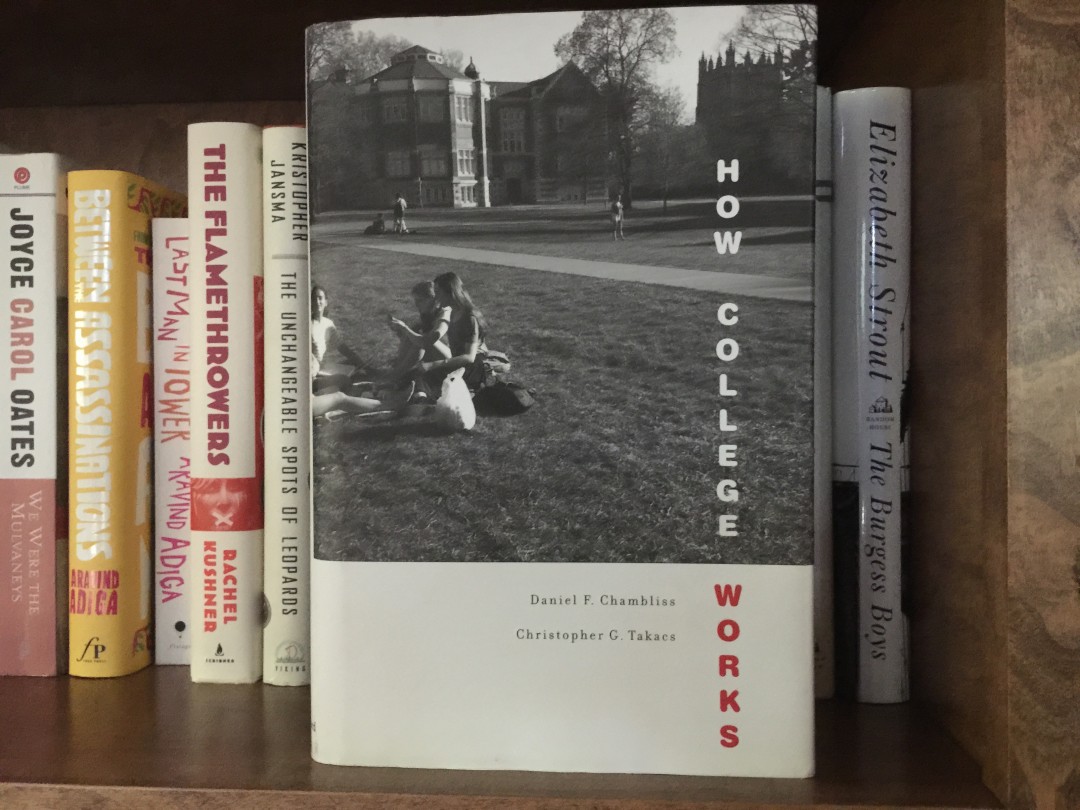Dan Chambliss and Christopher Takacs followed over 100 students over eight years at Hamilton College to see what works and what doesn’t. They show the reader how college works and see beyond the four years, with frequent commentary from alumni looking back at their college years and with insight into what choices paid off and what opportunities they missed. While they are researchers writing for an academic audience, and the book is a little dry, with more information about background methods than the lay reader wants, the core is a very reliable, persuasive guide to what needs to happen for a successful college experience (and if college isn’t successful, you’re unlikely to have a successful post-college launch, right?)
Interestingly, students don’t need to find a large group of great people—they need just a few—and those can come from nearly anywhere on campus. But those friends are crucial to success on all levels. And, although probably true all through life, it’s interesting to consider that friendships within one group may preclude friendships with other groups—whether due to time constraints or clannishness.
“Socially engaged students put more into their academic and intellectual work. Once established, solid relationships provide security and free the student from spending time constantly looking for friends.”
The randomness of teenagers choosing classes just to fill out a schedule, either because it’s available or fits with three other pre-reqs, or lets them sleep in, leads to all kinds of happy accidents. Students fall in love with majors they never would have considered, usually because they fall in love with a professor’s presentation. The authors note, “what happens the first year is decisive.” Even with faculty advisors, students need to have a bond with some of the professors from whom they actually take classes—they need those repeated interactions to form the kind of mentoring relationships needed to acquire skills and insight into a future beyond the college years.
I’ve very much found this to be true with our sons and their friends—the happiest, highest-achieving students all have at least one professor with whom they are working almost as colleagues. My older son has a panel of science professors guiding his graduate school process, a departmental chair for his minor with whom he handles all the student activity coordination—and he is grooming his student replacement, as well as a growing relationship with the Development office as he runs the academic club seniors’ effort towards the senior gift to the school. (Thinking about these sorts of relationships as a goal might fundamentally change the college selection process for a given student.)
The academic research nature of the book pays off in side notes like this one:
“When we talked to alums five and ten years out about teachers who influenced them, we were surprised to discover a relative handful of faculty accounted for a large percentage of mentors. Indeed, a single professor, recently retired from the college, accounted for a substantial—nearly 10 percent— of all positive comments we heard in our alumni sample. He was an exceptional mentor…He was crucially, in a department (Economics, as it happens) that saw lots of majors, and for a time he was the college’s dean of students, where again his skills could be widely applied…even the finest potential mentors can’t help much if they don’t meet a lot of early-career students.”
There’s interesting discussion on small classes: They seem ideal for having discussions and making friends, finding mentors, and igniting academic passions, but the flip side of small classes is that they fill up faster, so your student may have no access at all until much later in their academic career. At that point it may be too late to switch majors, add a minor, develop a mentor. Large classes can create large exposure for superstar teachers and provide common experiences that ignite campus conversations. Ultimately, the authors conclude that, “The arithmetic of engagement is about placing people to maximize the odds that any given student will meet friends and encounter good teachers, with all the benefits that can result.”
I loved the discussion of Hamilton’s college activities, which I think most people can translate to their own (or their student’s college). Some groups are core to the experience, with others on the periphery. At Hamilton most fraternities and sororities are not in the core, and “such comparatively ingrown organizations can actually limit a student’s connections with the broader institution.” For example, as at many schools, a particular fraternity was largely the same as a given sports team, so those students, despite being in two different campus groups, have an extremely limited network. (Much as campus romances that begin early in a college career can curtail outside friendships’ development.)
Another thing I like about this book is that they follow along a student’s journey, from freshman year until graduation, which gives a non-academic parent like me a bit of the much-appreciated “what to expect the college years” guide. Proof of my concept were comments about junior year that “clear writing is helpful for middle-management employees and crucial for professionals,” something businesses are repeatedly telling other pollsters and researchers that most grads from most schools just don’t have. In their alumni interviews they gather significant feedback that public speaking experience results on “increased confidence and the acquisition of a skill so relatively rare as to be decisive in career advancement.”
Recommendation? Fascinating book, although written for an academic audience. It’s not too long, but a bit of a slog with every statement carefully qualified. Still, I think this is essential reading for parents. Its insights ought to weigh heavily in choosing a college (if there’s any chance your student will listen to you or the authors). Absolutely critical for parents with students in college. Certainly if you’re getting unhappy calls or a lot of weekend visits, you’ll have a good idea what advice to give from home to help your student make it work. If you’ve got a happy student, you can still be asking questions and nudging as needed based on the insights from this research. There is no hope that a teen is going to read this book before or during college, but the information could be life-changing. Perhaps you can just get them to buy into the authors’ “simple practical advice: spend your time with good people.”





No Comments